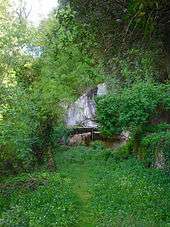Abrigo do Lagar Velho
| Lagar Velho (Abrigo do Lagar Velho) | |
| Archaeological Site of Lagar Velho | |
| Paleolithic site (Abrigo) | |
 A distant image of the karst topographic of the Valley of Lapedo, location of the shelter of Lagar Velho | |
| Official name: Vale do Lapedo | |
| Country | |
|---|---|
| Region | Centro |
| Sub-region | Pinhal Litoral |
| District | Leiria |
| Municipality | Leiria |
| Location | Santa Eufémia |
| - elevation | 101 m (331 ft) |
| - coordinates | PT 39°45′19.41″N 8°44′6.92″W / 39.7553917°N 8.7352556°WCoordinates: PT 39°45′19.41″N 8°44′6.92″W / 39.7553917°N 8.7352556°W |
| Length | 22.18 m (73 ft), Southwest-Northeast |
| Width | 8.39 m (28 ft), Northwest-Southeast |
| Architects | unknown |
| Style | Paleolithic |
| Material | Karst |
| Owner | Portuguese Republic |
| For public | Public |
| Easiest access | Santa Eufémia/Caranguejeira |
| Management | Instituto Gestão do Patrimonio Arquitectónico e Arqueológico |
| Operator | Centro de eLearning do Instituto Politécnico de Tomar (IPT) e Área |
| Wikimedia Commons: Abrigo do Lagar Velho | |
Lagar Velho is a rock-shelter in the Lapedo valley, a limestone canyon 13 km from the centre of Leiria, in the municipality of Leiria, in central Portugal. The site is known for the discovery of a 24,000-year-old Cro-Magnon child,[1] later referred to as the Lapedo child.
History

In archaeological terms, the site is known to integrate a stratigraphic sequence representative of much of the Upper Paleolithic human occupations of the region (between about 30,000 and 20,000 years), gathering at various levels respective traces and carved lithic remnants, associated with coeval faunal elements.[2]
In 1998, the discovery of an early Upper Paleolithic human burial site in the valley has provided evidence of early modern humans in southern Iberia. The remains, the largely complete skeleton of an approximately 4-year-old child, was buried with a pierced shell and red ochre (dated to circa 24,500 years B.P.).[2][3] The cranium, mandible, dentition, and postcrania appear to present a mosaic of European early modern human and Neanderthal features,[1][4] although this interpretation is disputed.[2][5][6] If the child was indeed a hybrid of anatomically modern humans and homo neanderthalensis, there could be significant implications regarding the Neanderthal interaction with Cro-Magnons and the taxonomical classification of these (possibly sub-) species.[2]
In addition to the burial context, recent archaeological campaigns have uncovered various levels of a Gravettian habitat, identifying an excellent state of preservation and original spatial organization.[2]
It is anticipated that archaeological museum, to be constructed in the Convent of Santo Agostinho (Portuguese: Convento de Santo Agostinho), in the city of Leiria, will house the skeletal remains.[2][3]
Geography
Situated between the civil parishes of Caranguejeira and Santa Eufémia, the Valley of Lapedo (Portuguese: Vale do Lapedo) is formed by the waters of the Ribeira de Caranguejeira.[3] It is an area of natural diversity of flora and fauna, that includes Carrion Crows (Corvus corone), eagles and field rats, in addition to Black, European or Common Alder (Alnus glutinosa), Willow (genus Salix), European or Common Ash (Fraxinus excelsior), Populus (family Salicaceae) and Vitis grapevines (of the family Vitaceae).[3]
References
- 1 2 "The Lagar Velho 1 Skeleton". Retrieved 6 April 2014.
- 1 2 3 4 5 6 IGESPAR, ed. (2011), Abrigo do Lagar Velho, Lapedo (in Portuguese), Lisbon, Portugal: IGESPAR - Instituto Gestão do Patrimonio Arquitectónico e Arqueológico, retrieved 8 September 2011
- 1 2 3 4 Matias, Cecília (2009). SIPA, ed. "Vale de Lapedo" (in Portuguese). Lisbon, Portugal: SIPA – Sistema de Informação para o Património Arquitectónico. Retrieved 8 September 2011.
- ↑ Duarte; Maurício, J; Pettitt, PB; Souto, P; Trinkaus, E; Van Der Plicht, H; Zilhão, J; et al. (1999). "The early Upper Paleolithic human skeleton from the Abrigo do Lagar Velho (Portugal) and modern human emergence in the Iberian Peninsula". Proceedings of the National Academy of Sciences of the United States of America. PNAS. 96 (13): 7604–7609. doi:10.1073/pnas.96.13.7604. PMC 22133
 . PMID 10377462. Retrieved 2009-06-21.
. PMID 10377462. Retrieved 2009-06-21. - ↑ Jones, Dan (3 March 2007). "The Neanderthal Within". New Scientist. pp. 28–32. doi:10.1016/S0262-4079(07)60550-8.
- ↑ Chunky Gravettian child; Ian Tattersall and Jeffrey H. Schwartz
External links
 Media related to Abrigo do Lagar Velho at Wikimedia Commons
Media related to Abrigo do Lagar Velho at Wikimedia Commons- Article in PNAS (1999)
- Article in Athena Review